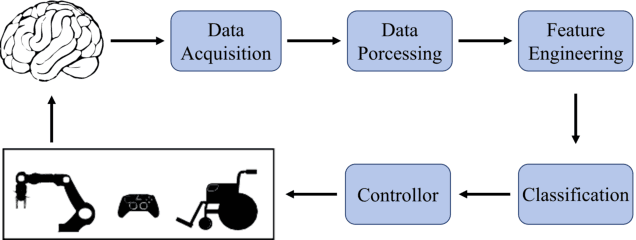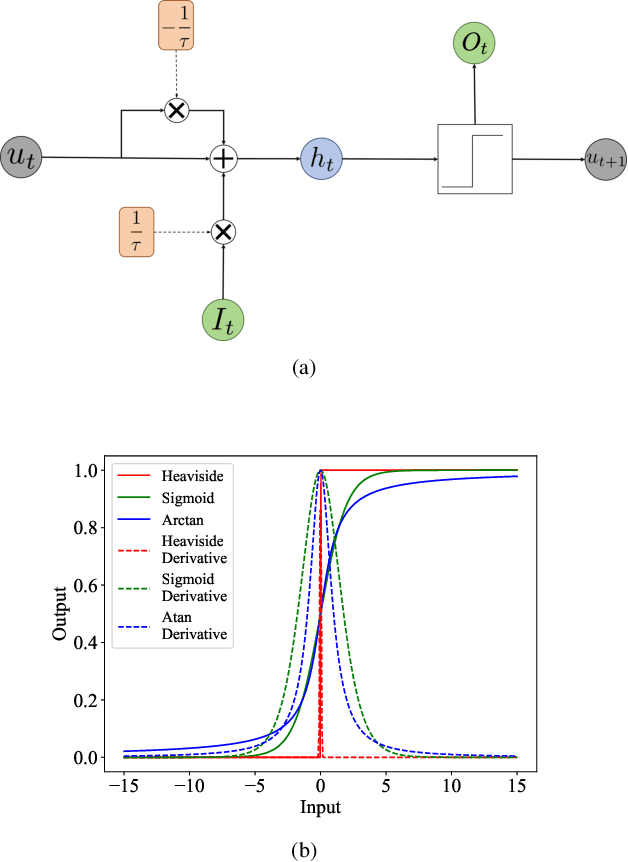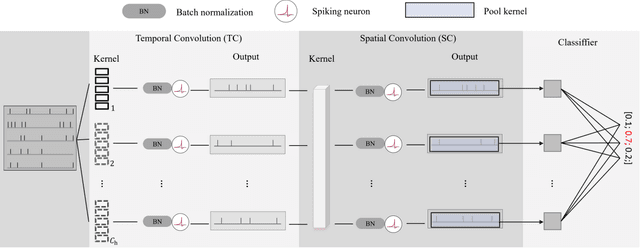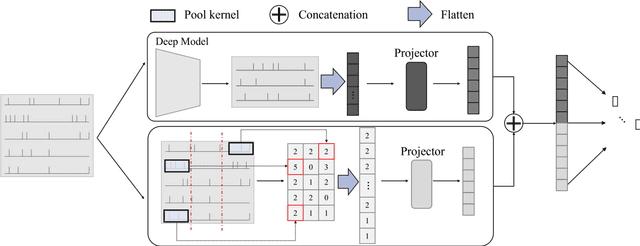Dongrui Wu
MIRepNet: A Pipeline and Foundation Model for EEG-Based Motor Imagery Classification
Jul 27, 2025Abstract:Brain-computer interfaces (BCIs) enable direct communication between the brain and external devices. Recent EEG foundation models aim to learn generalized representations across diverse BCI paradigms. However, these approaches overlook fundamental paradigm-specific neurophysiological distinctions, limiting their generalization ability. Importantly, in practical BCI deployments, the specific paradigm such as motor imagery (MI) for stroke rehabilitation or assistive robotics, is generally determined prior to data acquisition. This paper proposes MIRepNet, the first EEG foundation model tailored for the MI paradigm. MIRepNet comprises a high-quality EEG preprocessing pipeline incorporating a neurophysiologically-informed channel template, adaptable to EEG headsets with arbitrary electrode configurations. Furthermore, we introduce a hybrid pretraining strategy that combines self-supervised masked token reconstruction and supervised MI classification, facilitating rapid adaptation and accurate decoding on novel downstream MI tasks with fewer than 30 trials per class. Extensive evaluations across five public MI datasets demonstrated that MIRepNet consistently achieved state-of-the-art performance, significantly outperforming both specialized and generalized EEG models. Our code will be available on GitHub\footnote{https://github.com/staraink/MIRepNet}.
AFPM: Alignment-based Frame Patch Modeling for Cross-Dataset EEG Decoding
Jul 16, 2025Abstract:Electroencephalogram (EEG) decoding models for brain-computer interfaces (BCIs) struggle with cross-dataset learning and generalization due to channel layout inconsistencies, non-stationary signal distributions, and limited neurophysiological prior integration. To address these issues, we propose a plug-and-play Alignment-Based Frame-Patch Modeling (AFPM) framework, which has two main components: 1) Spatial Alignment, which selects task-relevant channels based on brain-region priors, aligns EEG distributions across domains, and remaps the selected channels to a unified layout; and, 2) Frame-Patch Encoding, which models multi-dataset signals into unified spatiotemporal patches for EEG decoding. Compared to 17 state-of-the-art approaches that need dataset-specific tuning, the proposed calibration-free AFPM achieves performance gains of up to 4.40% on motor imagery and 3.58% on event-related potential tasks. To our knowledge, this is the first calibration-free cross-dataset EEG decoding framework, substantially enhancing the practicalness of BCIs in real-world applications.
Magnetoencephalography (MEG) Based Non-Invasive Chinese Speech Decoding
Jun 15, 2025Abstract:As an emerging paradigm of brain-computer interfaces (BCIs), speech BCI has the potential to directly reflect auditory perception and thoughts, offering a promising communication alternative for patients with aphasia. Chinese is one of the most widely spoken languages in the world, whereas there is very limited research on speech BCIs for Chinese language. This paper reports a text-magnetoencephalography (MEG) dataset for non-invasive Chinese speech BCIs. It also proposes a multi-modality assisted speech decoding (MASD) algorithm to capture both text and acoustic information embedded in brain signals during speech activities. Experiment results demonstrated the effectiveness of both our text-MEG dataset and our proposed MASD algorithm. To our knowledge, this is the first study on modality-assisted decoding for non-invasive speech BCIs.
CLEAN-MI: A Scalable and Efficient Pipeline for Constructing High-Quality Neurodata in Motor Imagery Paradigm
Jun 13, 2025Abstract:The construction of large-scale, high-quality datasets is a fundamental prerequisite for developing robust and generalizable foundation models in motor imagery (MI)-based brain-computer interfaces (BCIs). However, EEG signals collected from different subjects and devices are often plagued by low signal-to-noise ratio, heterogeneity in electrode configurations, and substantial inter-subject variability, posing significant challenges for effective model training. In this paper, we propose CLEAN-MI, a scalable and systematic data construction pipeline for constructing large-scale, efficient, and accurate neurodata in the MI paradigm. CLEAN-MI integrates frequency band filtering, channel template selection, subject screening, and marginal distribution alignment to systematically filter out irrelevant or low-quality data and standardize multi-source EEG datasets. We demonstrate the effectiveness of CLEAN-MI on multiple public MI datasets, achieving consistent improvements in data quality and classification performance.
SACM: SEEG-Audio Contrastive Matching for Chinese Speech Decoding
May 26, 2025Abstract:Speech disorders such as dysarthria and anarthria can severely impair the patient's ability to communicate verbally. Speech decoding brain-computer interfaces (BCIs) offer a potential alternative by directly translating speech intentions into spoken words, serving as speech neuroprostheses. This paper reports an experimental protocol for Mandarin Chinese speech decoding BCIs, along with the corresponding decoding algorithms. Stereo-electroencephalography (SEEG) and synchronized audio data were collected from eight drug-resistant epilepsy patients as they conducted a word-level reading task. The proposed SEEG and Audio Contrastive Matching (SACM), a contrastive learning-based framework, achieved decoding accuracies significantly exceeding chance levels in both speech detection and speech decoding tasks. Electrode-wise analysis revealed that a single sensorimotor cortex electrode achieved performance comparable to that of the full electrode array. These findings provide valuable insights for developing more accurate online speech decoding BCIs.
Spiking Neural Network for Intra-cortical Brain Signal Decoding
Apr 12, 2025



Abstract:Decoding brain signals accurately and efficiently is crucial for intra-cortical brain-computer interfaces. Traditional decoding approaches based on neural activity vector features suffer from low accuracy, whereas deep learning based approaches have high computational cost. To improve both the decoding accuracy and efficiency, this paper proposes a spiking neural network (SNN) for effective and energy-efficient intra-cortical brain signal decoding. We also propose a feature fusion approach, which integrates the manually extracted neural activity vector features with those extracted by a deep neural network, to further improve the decoding accuracy. Experiments in decoding motor-related intra-cortical brain signals of two rhesus macaques demonstrated that our SNN model achieved higher accuracy than traditional artificial neural networks; more importantly, it was tens or hundreds of times more efficient. The SNN model is very suitable for high precision and low power applications like intra-cortical brain-computer interfaces.
CMCRD: Cross-Modal Contrastive Representation Distillation for Emotion Recognition
Apr 12, 2025



Abstract:Emotion recognition is an important component of affective computing, and also human-machine interaction. Unimodal emotion recognition is convenient, but the accuracy may not be high enough; on the contrary, multi-modal emotion recognition may be more accurate, but it also increases the complexity and cost of the data collection system. This paper considers cross-modal emotion recognition, i.e., using both electroencephalography (EEG) and eye movement in training, but only EEG or eye movement in test. We propose cross-modal contrastive representation distillation (CMCRD), which uses a pre-trained eye movement classification model to assist the training of an EEG classification model, improving feature extraction from EEG signals, or vice versa. During test, only EEG signals (or eye movement signals) are acquired, eliminating the need for multi-modal data. CMCRD not only improves the emotion recognition accuracy, but also makes the system more simplified and practical. Experiments using three different neural network architectures on three multi-modal emotion recognition datasets demonstrated the effectiveness of CMCRD. Compared with the EEG-only model, it improved the average classification accuracy by about 6.2%.
Spatial Distillation based Distribution Alignment (SDDA) for Cross-Headset EEG Classification
Mar 07, 2025Abstract:A non-invasive brain-computer interface (BCI) enables direct interaction between the user and external devices, typically via electroencephalogram (EEG) signals. However, decoding EEG signals across different headsets remains a significant challenge due to differences in the number and locations of the electrodes. To address this challenge, we propose a spatial distillation based distribution alignment (SDDA) approach for heterogeneous cross-headset transfer in non-invasive BCIs. SDDA uses first spatial distillation to make use of the full set of electrodes, and then input/feature/output space distribution alignments to cope with the significant differences between the source and target domains. To our knowledge, this is the first work to use knowledge distillation in cross-headset transfers. Extensive experiments on six EEG datasets from two BCI paradigms demonstrated that SDDA achieved superior performance in both offline unsupervised domain adaptation and online supervised domain adaptation scenarios, consistently outperforming 10 classical and state-of-the-art transfer learning algorithms.
Multi-View Contrastive Network (MVCNet) for Motor Imagery Classification
Feb 27, 2025Abstract:Objective: An electroencephalography (EEG)-based brain-computer interface (BCI) serves as a direct communication pathway between the human brain and an external device. While supervised learning has been extensively explored for motor imagery (MI) EEG classification, small data quantity has been a key factor limiting the performance of deep feature learning. Methods: This paper proposes a knowledge-driven time-space-frequency based multi-view contrastive network (MVCNet) for MI EEG decoding in BCIs. MVCNet integrates knowledge from the time, space, and frequency domains into the training process through data augmentations from multiple views, fostering more discriminative feature learning of the characteristics of EEG data. We introduce a cross-view contrasting module to learn from different augmented views and a cross-model contrasting module to enhance the consistency of features extracted between knowledge-guided and data-driven models. Results: The combination of EEG data augmentation strategies was systematically investigated for more informative supervised contrastive learning. Experiments on four public MI datasets and three different architectures demonstrated that MVCNet outperformed 10 existing approaches. Significance: Our approach can significantly boost EEG classification performance beyond designated networks, showcasing the potential to enhance the feature learning process for better EEG decoding.
Revisiting Euclidean Alignment for Transfer Learning in EEG-Based Brain-Computer Interfaces
Feb 13, 2025Abstract:Due to the non-stationarity and large individual differences of EEG signals, EEG-based brain-computer interfaces (BCIs) usually need subject-specific calibration to tailor the decoding algorithm for each new subject, which is time-consuming and user-unfriendly, hindering their real-world applications. Transfer learning (TL) has been extensively used to expedite the calibration, by making use of EEG data from other subjects/sessions. An important consideration in TL for EEG-based BCIs is to reduce the data distribution discrepancies among different subjects/session, to avoid negative transfer. Euclidean alignment (EA) was proposed in 2020 to address this challenge. Numerous experiments from 10 different BCI paradigms demonstrated its effectiveness and efficiency. This paper revisits the EA, explaining its procedure and correct usage, introducing its applications and extensions, and pointing out potential new research directions. It should be very helpful to BCI researchers, especially those who are working on EEG signal decoding.
 Add to Chrome
Add to Chrome Add to Firefox
Add to Firefox Add to Edge
Add to Edge